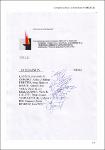Mostrar el registro sencillo del ítem
Evaluación del bienestar animal mediante la semiología ambiental, poblacional e individual : su incidencia en la producción tambera en el departamento de Chapaleufú, provincia de La Pampa, Argentina
Assessment of animal welfare through environmental semiotics, population and individual : its incidence in the production department tambera Chapaleufú in the province of La Pampa, Argentina
| dc.contributor.author | Otrosky, Roberto Nelson (director) | |
| dc.contributor.author | Heritier, Jorge Melchor (co-director) | |
| dc.contributor.author | Rio, Fernando Javier (investigador) | |
| dc.contributor.author | Vera, Oscar Arturo (investigador) | |
| dc.contributor.author | Ierace, Antonio José Marcelo (investigador) | |
| dc.contributor.author | Della Croce, Mario Roberto (investigador) | |
| dc.contributor.author | Galetti, Ericka Juliana Rosa (investigadora) | |
| dc.contributor.author | Véspoli Pucheu, María Verónica (investigadora) | |
| dc.contributor.author | Remirez, Luis Pablo (investigador) | |
| dc.contributor.other | Lagger, José Rodolfo (asesor) | |
| dc.date.accessioned | 2020-08-09T18:11:10Z | |
| dc.date.available | 2020-08-09T18:11:10Z | |
| dc.date.issued | 2012-07-01 | |
| dc.identifier.uri | https://repo.unlpam.edu.ar/handle/unlpam/634 | |
| dc.description.abstract | Durante el siglo XX, la Medicina Veterinaria mundial advierte sobre la necesidad de iniciar estudios científicos referentes al bienestar animal. En la actualidad el tema adquiere su real importancia desde la bioética, el respeto hacia el animal, las normativas internacionales y el conocimiento de su incidencia sobre la producción pecuaria. En el tambo, la extracción de la leche depende del equilibrio entre la acción conjunta de la ordeñadora y de la liberación hormonal del propio animal que puede afectarse por factores negativos externos que aumentan el volumen de leche residual. Esto da como resultado una merma de producción y un aumento del riesgo de mastitis. Estos factores externos ligados directa o indirectamente a situaciones de estrés alteran el biorritmo del individuo y de la población a la que pertenece. Este trabajo pretende evaluar la incidencia del bienestar animal en la producción tambera del Departamento de Chapaleufú, provincia de La Pampa, desde la óptica de la semiología ambiental, poblacional e individual y su correlación con los niveles de cortisol plasmático como marcador del nivel de stress individual y poblacional. | |
| dc.description.abstract | During the Twentieth Century Veterinary Medicine warns about the need to initiate scientific studies relating to animal welfare, respect for animals and its impact on livestock production. Milk production depends on the balance between the technology of milking, the physiology of the animal that can be affected by negative external factors affecting comfort. It is important to arrive at a diagnosis to achieve control of the current situation. It is necessary to specify which group of risk is the affected (cows postpartum, pregnant, dried, served, etc.). To locate problems and how they started, link it with risk factors such as age, calving, races, lactation, production levels, weight postpartum, changes in management, climate, nutrition, new operators, etc. Based on individual and population semiology, start with a review, collection of data on the owner, data from animals that allow direct pathologies. Continuing with the anamnesis, series of organized and concise and direct questions to the owner, manager, tambero, etc. The questions will be targeted to the antiquity of the demonstrations, animals affected, economic value and the environment. We will listen to the story of the person that interacts with the animal. The clinical examination, enables collection of signs (objective expression) as opposed to human medicine in which symptoms are also obtained (subjective expression). It includes maneuvers of inspection in general and in particular, palpation, percussion, auscultation, sucusion and olfactics. Extraction of a representative sample of the population to be analyzed and the results should be considered for population semiology. | en |
| dc.language.iso | spa | |
| dc.rights | Atribución-NoComercial-CompartirIgual 2.5 Argentina (CC BY-NC-SA 2.5 AR) | |
| dc.rights.uri | https://creativecommons.org/licenses/by-nc-sa/2.5/ar/ | |
| dc.title | Evaluación del bienestar animal mediante la semiología ambiental, poblacional e individual : su incidencia en la producción tambera en el departamento de Chapaleufú, provincia de La Pampa, Argentina | es_AR |
| dc.title | Assessment of animal welfare through environmental semiotics, population and individual : its incidence in the production department tambera Chapaleufú in the province of La Pampa, Argentina | en |
| dc.type | proyecto de investigación | |
| dc.unlpam.instituciondeorigen | Facultad de Ciencias Veterinarias | |
| dc.unlpam.version | publishedVersion | |
| dc.unlpam.resolucion | 336/12 CD-FCV | |
| dc.unlpam.monto | $16.650,00 | |
| dc.unlpam.otorgante | UNLPam | |
| dc.unlpam.fechfin1 | 2016-06-30 | |
| dc.subject.keyword | Vital signs | |
| dc.subject.keyword | Cortisol | |
| dc.subject.keyword | Anomal welfare | |
| dc.subject.keyword | Dairy farms | |
| dc.subject.palabraclave | Signos vitales | |
| dc.subject.palabraclave | Cortisol | |
| dc.subject.palabraclave | Bienestar animal | |
| dc.subject.palabraclave | Tambos |
Ficheros en el ítem
Este ítem aparece en la(s) siguiente(s) colección(ones)
-
Proyectos [402]











